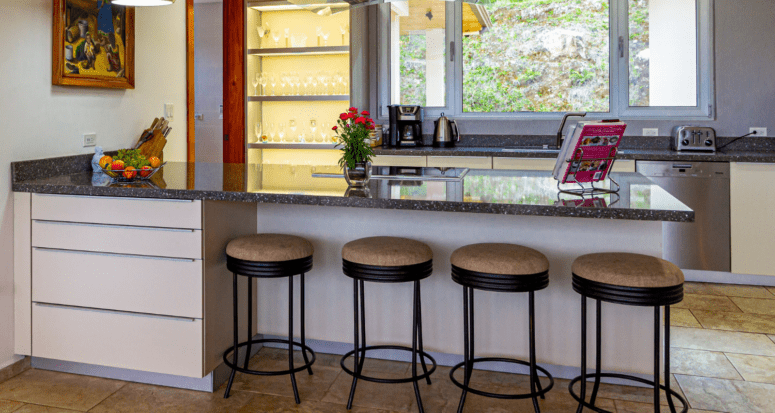9 Kitchen Remodel Tips to Improve the Most Complex Room of the House
- Published on
- 3 to 4 min read
-
 Melissa Stewart Contributing AuthorClose
Melissa Stewart Contributing AuthorClose Melissa Stewart Contributing Author
Melissa Stewart Contributing AuthorMelissa Stewart has been a content creator and journalist for 20 years. After earning her degree in Magazine Journalism from Syracuse University, she spent much of her career in the lifestyle publishing industry, including helping readers discover the best places to live and giving them an inside look at some amazing interiors. She now freelances from the Virginia Beach suburbs, where she resides in her version of the perfect family home.
You love your home, but the patterned Formica countertops and dark cabinets in the kitchen have got to go. Cooking, too, has become a pain with a stove that offers little to no temperature control. Meanwhile, plates and bowls come out of the dishwasher caked with food, pots and pans have no designated home, and your kitchen drawers are overflowing with gadgets. You need a kitchen revamp, and you need it now!
As it happens, kitchens remain the single most popular room to renovate in large part because of their heavy use. According to Houzz’s latest Renovation Trends study, 26% of homeowners who remodeled in 2019 chose to tackle the space where they cook and dine. Because kitchens are such a high traffic room, key improvements can instantly reduce daily frustrations and give your home a cosmetic facelift.
“It will always be the most important room in the house, I believe,” says top-selling Chicago-area real estate agent Melanie Giglio.
“It’s the place where the family congregates, where you eat, where you cook.”
However, a maze of mechanical, electrical, and plumbing components adds expense and complexity to any kitchen remodel. You should expect to pay anywhere from $10,000 for DIY spruce up to north of $100,000 for a chef’s paradise, and to encounter surprise costs along the way.
To help you get to a place of total kitchen zen, we researched style trends and budgeting advice online, dug into recent market data around the hottest kitchen features, and gathered firsthand insights from an award-winning kitchen designer. With that, we bring you these 9 kitchen remodel tips for creating a functional space your family will enjoy for years to come.

1. Don’t hire a contractor on impulse
This is a big one: The average kitchen remodel takes 6-8 weeks, or 10-12 weeks if the project involves structural changes. Kitchen work also requires a variety of subcontractors, which may include an electrician, plumber, painter, and marble installer or tiler.
For a project of this scope and size, you need to find a top-notch general contractor to run point and manage all the moving parts. Any remodel is disruptive and stressful, but if you don’t have someone in charge who’s easy to communicate with, the results of this investment could leave you majorly disappointed.
ConsumerAffairs, a nonprofit provider of research-driven e-sources and reviews aimed at helping people make smarter buying decisions since 1998, recommends the following tips when searching for your contractor:
Check their licensing and certification:
Call your state’s licensing division or do a search for your state’s contractor licensing requirements online. Then, ask your contractor for proof of their licensing and certification to see if it aligns with local regulations. Make sure the person you hire also has liability insurance and worker’s comp.
Review examples of their finished kitchen projects specifically:
Make sure they’ve done kitchen renovations recently without a large gap between projects. See if you like their style and end product. Keep your eyes open for materials that look cheap, insufficient lighting, or a lack of storage. Check that their designs include a logical layout of the kitchen triangle, i.e. the stove, fridge, and sink, for a great kitchen flow.
Call references:
For any final candidates, ask if you can have the contact information of past clients and give them a ring. If the contractor can’t produce a list for you — or the people you speak with sound hesitant when answering your questions — consider it a red flag.
2. Create a temporary kitchen to reduce disruption
With a patio addition, the chaos is mostly contained to the outside. With a single bathroom renovation, you can always use the other bathroom while one is under construction. But with a kitchen remodel? Suddenly, tasks as simple as making coffee, grabbing a beverage out of the fridge, or washing a dish become a major inconvenience.
To create a stopgap and reduce stress, Mike Lotz, the lead kitchen designer and cabinet specialist for Bluestem Construction serving the Twin Cities, and winner of a 2020 Contractor of the Year Award (CotY), has a solution: “Designate a space for a temporary kitchen, ideally close to a secondary water source like a bathroom sink,” he says.
Lotz recommends setting up a meal prep area with a microwave, portable grill, or hot plate and folding tables with cutting boards as makeshift countertops. Keep the old refrigerator in place until your new one is delivered because you’ll need full capacity for easy meals. It’s also helpful to select an area for storing materials, cabinets, appliances, and countertops as they’re delivered and before they’re installed.
3. Don’t move any appliance other than the fridge
To save money and hassle, leave all appliances and fixtures in their current location, especially the sink, if at all possible. Moving gas, electric lines, and plumbing is time consuming and costly. For example, home remodeling website Fixr reports that installing new plumbing in a kitchen costs an of average $5,500. The only exception to this is the fridge since it only requires an outlet, and as the largest appliance, it can have the biggest impact on the layout.

4. On a budget? Paint your cabinets instead of replacing them
Best case scenario: You rip out your dated cabinets in favor of a fresh look. But installing all new cabinetry can be one of the costliest parts of a kitchen remodel. According to HomeAdvisor, the average cost of new cabinetry stands at around $5,120.
Sounds like a budget-buster, but Giglio — the top Chicago real estate agent — insists that creating a neutral, timeless backdrop is crucial for resale value and enhancing your home’s marketability.
“If you really want to have something stand the test of time, stick to the whites or gray,” she says. Her solution for homeowners on a budget? Paint your cabinets with a fresh coat of white (be sure to paint both the inside and outside of the doors) for a cheap but dramatic transformation.
5. Install pull-outs to more easily access pots, pans, and appliances
Our research shows that 57% of top real estate agents nationwide cite plenty of drawer and cabinet storage as a top kitchen upgrade in 2021. But you can have kitchen cabinets deep enough to comfortably store your crockpot, air fryer, and blender in one place and still be annoyed with your setup. What if you need your go-to frying pan for a quick egg scramble, but it’s buried behind your saucepans and strainers? In addition to having enough storage, a great kitchen design also makes it super easy to access whatever you need, whenever you need it.
Enter kitchen cabinet pull-outs, also known as slide-out shelves. Rather than having to reach your head into a dark cabinet abyss, slide-out shelves come to you. You can install these shelves for your spices, pantry items, and small appliances alike. A pull-out for your trash and recycling also creates more floor space, and a toe-kick drawer — located between the cabinets and floor — offers additional hidden storage that blends into the baseboards.
6. Prioritize a kitchen island and walk-in pantry
A kitchen island gives you extra counter space to chop veggies or set up bar stools for an additional seating area. Meanwhile, a walk-in pantry provides ample storage to organize your food and stock up on groceries. It’s easy to see why both of these features rank at the very top of homebuyer kitchen wishlists in 2021, and by adding them, you make your home more marketable and potentially boost resale value.
Trending kitchen island designs include the custom waterfall style, double island, and two-tier island. To hide unsightly cords, ask your contractor about cutting a hole in the surface of the island to add a pop-up outlet. Need help with building your pantry? We’ve got you covered with our walk-in pantry project planning guide.
7. Keep your design lines clean
Lotz notes that people are gravitating to more streamlined designs in the kitchen without being too sterile or clinical. Achieve this look by selecting an ultra-thin, 1cm stone countertop or slab cabinet doors like this KraftMaid option from Ferguson, available in a variety of wood types and colors. Bonus: flat cabinets are easier to clean because they don’t have crevices that collect dust.

8. Get rid of the dark, busy countertops
In the 1990s and early 2000s, people gravitated toward bolder, busier, and darker countertop slabs. Recent years have seen a shift toward solid, lighter colors, such as white with subtle grey-veined patterns that emulate Carrera marble, or more subdued speckled patterns. If you have the dark speckled granite countertops in your kitchen that scream early 2000s, make sure to switch to a more modern style. Consider a material such as non-porous quartz in a matte or leathered finish that is less likely to show smudges or debris. Other trendy options include marble, concrete, or butcher block.
9. Consider your family’s needs
“Every space and situation is different, but consider where people will work, walk through, or congregate,” suggests Lotz. If you work from home or need an extra spot for your kids to do homework, prioritize a kitchen office. Do you love to entertain? Take the walk-in pantry to a new level by adding a butler’s pantry complete with counters for food prep and appliances to keep the work of hosting hidden.
Kitchen remodels: High risk, high reward
The kitchen has always been the home base of the household. It’s typically where a family’s day begins and where they regroup in the evening over a good meal. As such, an updated kitchen can immediately boost your enjoyment of your home and help you sell it for more down the line.
However, the kitchen can also be the most complex room to renovate, given the mix of mechanical features and cosmetic choices involved. Be sure to give ample time to plan for the project and incorporate marketable features like light countertops and cabinetry, plenty of storage, and a kitchen island. That way, you’ll end up with a kitchen remodel worthy of your home’s most sought-after space. “It’s where all the magic happens,” says Giglio.
Header Image Source: (fran hogan /Unsplash)
